calsfoundation@cals.org
Reconnaissance toward Van Buren and Fort Smith (November 20–23, 1862)
On November 20, 1862, Brigadier General James G. Blunt dispatched 600 cavalrymen led by Lieutenant Colonel Lewis R. Jewell of the Sixth Kansas Cavalry from Union Camp Babcock north of present-day Siloam Springs (Benton County) to gather intelligence about Confederate forces converging in the Arkansas River Valley around Van Buren (Crawford County) and Fort Smith (Sebastian County).
Jewell, leading two battalions of the Sixth Kansas Cavalry and one of the Third Indian Home Guard, proceeded south through the Boston Mountains until he encountered Confederate pickets on the Line Road about fifteen miles north of Van Buren. Though the rebels retreated, Jewell, “learning that a large force was at Van Buren…deemed it prudent to proceed no further,” Blunt stated in his report to Major General Samuel R. Curtis; the scouting party returned to Camp Babcock on the evening of November 23.
Blunt reported that “information obtained from various sources” by Jewell during the reconnaissance, “which I deem quite reliable,” held that Confederate forces under Major General Thomas C. Hindman, Brigadier General John Sappington Marmaduke, Brigadier General Douglas Cooper, and Colonel Stand Watie had gathered in the two Arkansas River Valley towns. While Jewell’s estimate maintained that as many as 30,000 Confederates had converged, Blunt reported, “I am quite sure it does not exceed 15,000 effective men, and probably not over 12,000.” He was correct; when Hindman advanced north in early December, he led an army of 12,000 soldiers.
Blunt wrote to Curtis that, with “a small re-enforcement,” he could detail a security force at Evansville (Washington County) to protect his rear while he attacked the main Confederate force. However, on November 24, he learned that Marmaduke was returning to Cane Hill (Washington County) to gather supplies, leading the pugnacious Blunt to decide to attack him, which he did in the November 28 Engagement at Cane Hill. Blunt’s Kansas Division remained at Cane Hill after that battle instead of returning to Camp Babcock, setting the stage for the December 7, 1862, Battle of Prairie Grove.
For additional information:
Shea, William L. Fields of Blood: The Prairie Grove Campaign. Chapel Hill: University of North Carolina Press, 2009.
The War of the Rebellion: A Compilation of the Official Records of the Union and Confederate Armies, Series I, Vol. 22, part 1, pp. 36–37. Washington DC: Government Printing Office, 1888.
Mark K. Christ
Central Arkansas Library System
 Civil War Timeline
Civil War Timeline Military
Military James Blunt
James Blunt 




Comments
No comments on this entry yet.